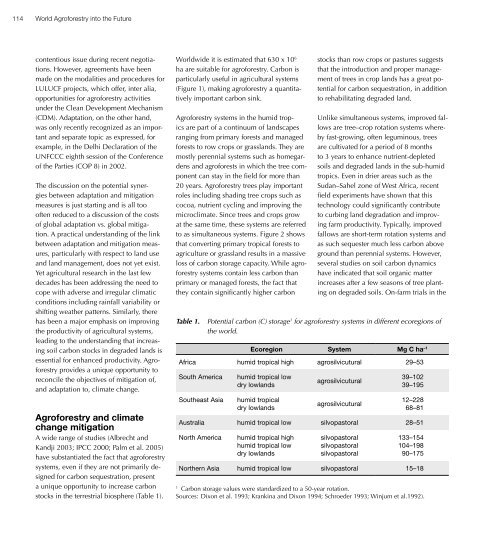The challenge of HIV/AIDS: Where does agroforestry fit in? - World ...
The challenge of HIV/AIDS: Where does agroforestry fit in? - World ...
The challenge of HIV/AIDS: Where does agroforestry fit in? - World ...
Create successful ePaper yourself
Turn your PDF publications into a flip-book with our unique Google optimized e-Paper software.
114<strong>World</strong> Agr<strong>of</strong>orestry <strong>in</strong>to the Futurecontentious issue dur<strong>in</strong>g recent negotiations.However, agreements have beenmade on the modalities and procedures forLULUCF projects, which <strong>of</strong>fer, <strong>in</strong>ter alia,opportunities for agr<strong>of</strong>orestry activitiesunder the Clean Development Mechanism(CDM). Adaptation, on the other hand,was only recently recognized as an importantand separate topic as expressed, forexample, <strong>in</strong> the Delhi Declaration <strong>of</strong> theUNFCCC eighth session <strong>of</strong> the Conference<strong>of</strong> the Parties (COP 8) <strong>in</strong> 2002.<strong>The</strong> discussion on the potential synergiesbetween adaptation and mitigationmeasures is just start<strong>in</strong>g and is all too<strong>of</strong>ten reduced to a discussion <strong>of</strong> the costs<strong>of</strong> global adaptation vs. global mitigation.A practical understand<strong>in</strong>g <strong>of</strong> the l<strong>in</strong>kbetween adaptation and mitigation measures,particularly with respect to land useand land management, <strong>does</strong> not yet exist.Yet agricultural research <strong>in</strong> the last fewdecades has been address<strong>in</strong>g the need tocope with adverse and irregular climaticconditions <strong>in</strong>clud<strong>in</strong>g ra<strong>in</strong>fall variability orshift<strong>in</strong>g weather patterns. Similarly, therehas been a major emphasis on improv<strong>in</strong>gthe productivity <strong>of</strong> agricultural systems,lead<strong>in</strong>g to the understand<strong>in</strong>g that <strong>in</strong>creas<strong>in</strong>gsoil carbon stocks <strong>in</strong> degraded lands isessential for enhanced productivity. Agr<strong>of</strong>orestryprovides a unique opportunity toreconcile the objectives <strong>of</strong> mitigation <strong>of</strong>,and adaptation to, climate change.Agr<strong>of</strong>orestry and climatechange mitigationA wide range <strong>of</strong> studies (Albrecht andKandji 2003; IPCC 2000; Palm et al. 2005)have substantiated the fact that agr<strong>of</strong>orestrysystems, even if they are not primarily designedfor carbon sequestration, presenta unique opportunity to <strong>in</strong>crease carbonstocks <strong>in</strong> the terrestrial biosphere (Table 1).<strong>World</strong>wide it is estimated that 630 x 10 6ha are suitable for agr<strong>of</strong>orestry. Carbon isparticularly useful <strong>in</strong> agricultural systems(Figure 1), mak<strong>in</strong>g agr<strong>of</strong>orestry a quantitativelyimportant carbon s<strong>in</strong>k.Agr<strong>of</strong>orestry systems <strong>in</strong> the humid tropicsare part <strong>of</strong> a cont<strong>in</strong>uum <strong>of</strong> landscapesrang<strong>in</strong>g from primary forests and managedforests to row crops or grasslands. <strong>The</strong>y aremostly perennial systems such as homegardensand agr<strong>of</strong>orests <strong>in</strong> which the tree componentcan stay <strong>in</strong> the field for more than20 years. Agr<strong>of</strong>orestry trees play importantroles <strong>in</strong>clud<strong>in</strong>g shad<strong>in</strong>g tree crops such ascocoa, nutrient cycl<strong>in</strong>g and improv<strong>in</strong>g themicroclimate. S<strong>in</strong>ce trees and crops growat the same time, these systems are referredto as simultaneous systems. Figure 2 showsthat convert<strong>in</strong>g primary tropical forests toagriculture or grassland results <strong>in</strong> a massiveloss <strong>of</strong> carbon storage capacity. While agr<strong>of</strong>orestrysystems conta<strong>in</strong> less carbon thanprimary or managed forests, the fact thatthey conta<strong>in</strong> significantly higher carbonTable 1.Potential carbon (C) storage 1 for agr<strong>of</strong>orestry systems <strong>in</strong> different ecoregions <strong>of</strong>the world.Ecoregion System Mg C ha –1Africa humid tropical high agrosilvicutural 29–53South AmericaSoutheast Asiahumid tropical lowdry lowlandshumid tropicaldry lowlandsagrosilvicuturalagrosilvicutural39–10239–19512–22868–81Australia humid tropical low silvopastoral 28–51North Americahumid tropical highhumid tropical lowdry lowlandsstocks than row crops or pastures suggeststhat the <strong>in</strong>troduction and proper management<strong>of</strong> trees <strong>in</strong> crop lands has a great potentialfor carbon sequestration, <strong>in</strong> additionto rehabilitat<strong>in</strong>g degraded land.Unlike simultaneous systems, improved fallowsare tree–crop rotation systems wherebyfast-grow<strong>in</strong>g, <strong>of</strong>ten legum<strong>in</strong>ous, treesare cultivated for a period <strong>of</strong> 8 monthsto 3 years to enhance nutrient-depletedsoils and degraded lands <strong>in</strong> the sub-humidtropics. Even <strong>in</strong> drier areas such as theSudan–Sahel zone <strong>of</strong> West Africa, recentfield experiments have shown that thistechnology could significantly contributeto curb<strong>in</strong>g land degradation and improv<strong>in</strong>gfarm productivity. Typically, improvedfallows are short-term rotation systems andas such sequester much less carbon aboveground than perennial systems. However,several studies on soil carbon dynamicshave <strong>in</strong>dicated that soil organic matter<strong>in</strong>creases after a few seasons <strong>of</strong> tree plant<strong>in</strong>gon degraded soils. On-farm trials <strong>in</strong> thesilvopastoralsilvopastoralsilvopastoral133–154104–19890–175Northern Asia humid tropical low silvopastoral 15–181Carbon storage values were standardized to a 50-year rotation.Sources: Dixon et al. 1993; Krank<strong>in</strong>a and Dixon 1994; Schroeder 1993; W<strong>in</strong>jum et al.1992).




![MNC_00_Modau [Compatibility Mode].pdf](https://img.yumpu.com/51432208/1/190x146/mnc-00-modau-compatibility-modepdf.jpg?quality=85)











